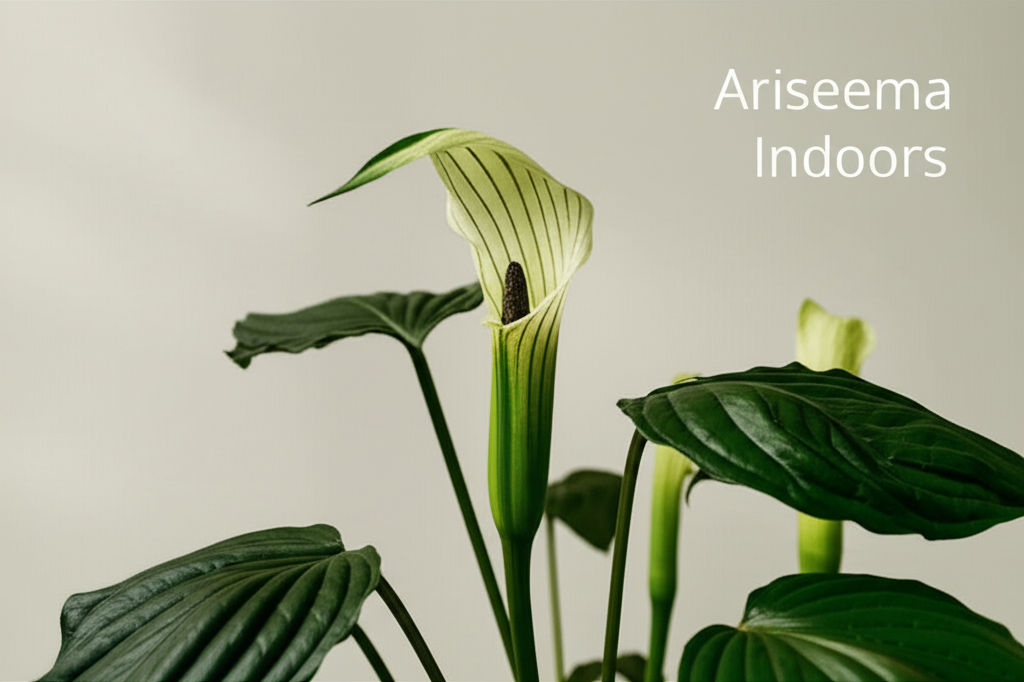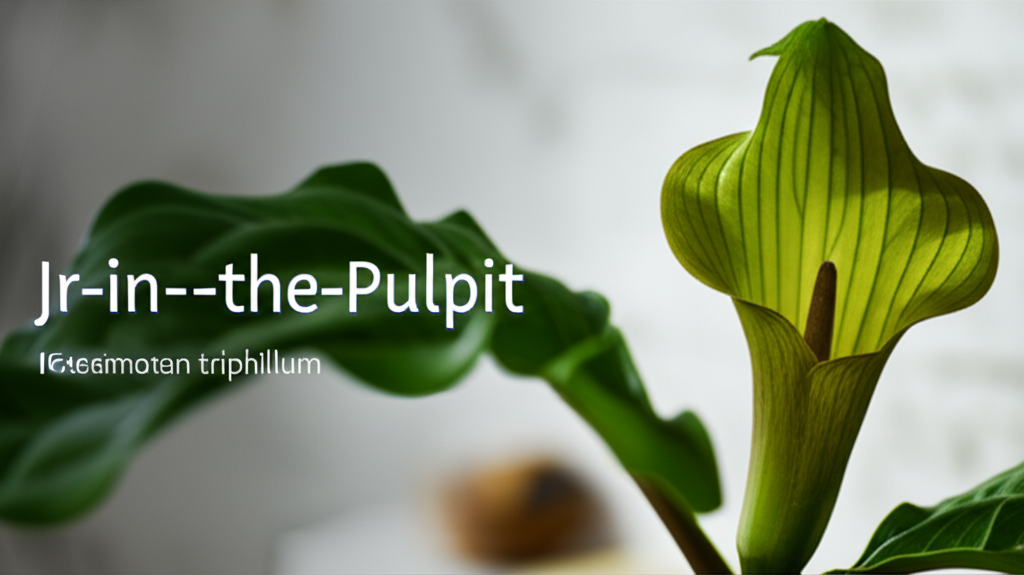The Mystique of the Jack-in-the-Pulpit: A Woodland Jewel for Your Home
For plant enthusiasts seeking a touch of the extraordinary, the Jack-in-the-Pulpit (Arisaema triphyllum) offers a captivating blend of botanical intrigue and unique aesthetic appeal. Native to the shaded woodlands of eastern North America, this fascinating perennial is renowned for its distinctive, hooded flower spathe that famously resembles a preacher at a pulpit. While its natural habitat is the dappled sunlight of a forest floor, with the right care and understanding, the Jack-in-the-Pulpit can thrive as an indoor specimen, bringing a piece of the wild’s magic into your living space. This comprehensive guide will equip you with all the knowledge needed to successfully cultivate this enigmatic plant indoors, from understanding its lifecycle to troubleshooting common issues.
Understanding the Jack-in-the-Pulpit’s Unique Biology

Before diving into cultivation, it’s crucial to appreciate the Jack-in-the-Pulpit’s peculiar botanical structure and life cycle. This plant belongs to the Araceae family, which includes other well-known members like peace lilies and anthuriums.
The Iconic Inflorescence: Spathe and Spadix
The most striking feature of the Jack-in-the-Pulpit is its flower, or more accurately, its inflorescence. This structure consists of two main parts:
- The Spathe: This is the hooded, leaf-like sheath that encloses the spadix. It typically arches over, creating the “pulpit” effect. The spathe can vary in color, often exhibiting shades of green, purple, or brown, and may be striped or mottled.
- The Spadix: This is the fleshy spike that emerges from the base of the spathe. It bears the tiny, true flowers, which are often inconspicuous and greenish. The spadix is often tipped with a sterile appendage that can vary in length.
A Remarkable Lifecycle: Sex Change and Dormancy
What truly sets the Jack-in-the-Pulpit apart is its ability to change sex. Most plants start life as male. As they mature and accumulate energy reserves in their underground corm, they can transition to female in subsequent years. This remarkable adaptation ensures cross-pollination and seed production.
Another key aspect of its life cycle is its period of dormancy. After flowering and producing berries (which are toxic to humans but a food source for some wildlife), the plant typically dies back to the ground in late summer or fall. The underground corm then enters a resting phase, preparing for the next growing season. This dormancy is vital for the plant’s survival and must be respected when growing it indoors.
Key Facts and Comparison: Jack-in-the-Pulpit vs. Other Houseplants
When considering the Jack-in-the-Pulpit for indoor cultivation, it’s helpful to compare its needs and characteristics to more common houseplants. This table highlights its unique requirements.
| Feature | Jack-in-the-Pulpit (Arisaema triphyllum) | Peace Lily (Spathiphyllum spp.) | Orchid (e.g., Phalaenopsis spp.) | Snake Plant (Sansevieria trifasciata) |
|---|---|---|---|---|
| Light Needs | Low to medium indirect light; avoid direct sun. | Medium to low indirect light; tolerates low light. | Bright, indirect light; avoid direct sun. | Low to bright indirect light; highly adaptable. |
| Watering | Keep consistently moist during growth; allow to dry slightly between waterings during dormancy. | Keep soil consistently moist; avoid waterlogging. | Allow potting medium to dry between waterings; sensitive to overwatering. | Allow soil to dry out completely between waterings; drought-tolerant. |
| Humidity | Prefers moderate to high humidity. | Prefers moderate to high humidity. | Prefers high humidity. | Tolerates average household humidity. |
| Soil | Rich, well-draining, organic-rich potting mix. | Well-draining, peat-based potting mix. | Special orchid bark mix or very airy, well-draining medium. | Well-draining cactus/succulent mix. |
| Dormancy | Required (late summer/fall). | No distinct dormancy period. | No distinct dormancy period. | No distinct dormancy period. |
| Toxicity | All parts are toxic if ingested (contains calcium oxalate crystals). | Toxic if ingested (contains calcium oxalate crystals). | Non-toxic. | Mildly toxic if ingested (contains saponins). |
| Unique Feature | Distinctive spathe and spadix; sex-changing ability. | White spathes; air-purifying qualities. | Exotic blooms; epiphytic nature. | Stiff, upright foliage; air-purifying qualities. |
Cultivating Your Indoor Jack-in-the-Pulpit: A Step-by-Step Approach
Bringing the Jack-in-the-Pulpit indoors requires a thoughtful approach to replicate its natural woodland environment as closely as possible.
1. Sourcing Your Plant: Corms or Seedlings?
The most common way to acquire a Jack-in-the-Pulpit for indoor cultivation is by purchasing a dormant corm. These are often available from specialty nurseries or online retailers during the fall and winter months. You may also find established seedlings, which can be easier for beginners as they are already past the initial germination stage.
2. Choosing the Right Pot and Potting Mix
- Pot: Select a pot that is at least 6-8 inches deep to accommodate the developing root system and the underground corm. Ensure the pot has adequate drainage holes to prevent waterlogged soil. Terracotta pots are an excellent choice as they allow for good aeration and help prevent overwatering.
- Potting Mix: A rich, well-draining, and slightly acidic potting mix is ideal. A good blend can be achieved by combining:
2 parts high-quality potting soil
1 part compost or well-rotted leaf mold
1 part perlite or coarse sand for drainage
3. Planting the Corm
If you have purchased a dormant corm, plant it in the prepared pot with the growing point (where the shoot emerges) facing upwards. Plant the corm about 3-4 inches deep in the soil. Water lightly after planting.
4. Providing Optimal Light Conditions
Jack-in-the-Pulpits thrive in low to medium indirect light. Think of the dappled sunlight that filters through a forest canopy.
- Ideal Placement: A north-facing or east-facing window is usually perfect. Alternatively, place it a few feet away from a brighter window, or behind a sheer curtain to diffuse the light.
- Avoid: Direct sunlight, especially during the hottest parts of the day, will scorch the leaves and can overheat the soil.
5. Mastering the Watering Routine
Consistent moisture is key during the active growing season.
- Growing Season (Spring to Summer): Keep the soil consistently moist but not soggy. Water thoroughly when the top inch of soil begins to feel dry. Feel free to let the soil dry out slightly more as the plant matures and its leaves begin to yellow.
- Dormancy (Late Summer/Fall onwards): Once the foliage dies back, significantly reduce watering. Allow the soil to dry out almost completely. This dormant period is essential for the plant’s health and encourages it to store energy in its corm for the following year.
6. Humidity and Temperature Needs
Jack-in-the-Pulpits appreciate moderate to high humidity.
- Increasing Humidity:
Place the pot on a pebble tray filled with water (ensure the bottom of the pot is not submerged).
Mist the foliage occasionally with water, especially during dry winter months.
Group plants together, as this can create a more humid microclimate.
- Temperature: Average room temperatures (65-75°F or 18-24°C) are generally suitable during the growing season. They can tolerate cooler temperatures during their dormant period.
7. Fertilizing for Growth
Feed your Jack-in-the-Pulpit sparingly during its active growth phase.
- Frequency: Apply a balanced liquid fertilizer, diluted to half strength, once a month from early spring through summer.
- Avoid: Fertilizing during the dormant period, as this can stimulate growth when the plant needs to rest.
8. Repotting and Division
Jack-in-the-Pulpits generally prefer to be slightly pot-bound and do not require frequent repotting.
- When to Repot: Repot every 2-3 years, or when you notice the corm has outgrown its current container. The best time to repot is during its dormant period in late fall or early winter, just before new growth is expected.
- Division: While repotting, you may notice offsets or smaller corms growing from the main corm. These can be carefully separated and planted individually. This is also a good time to divide overcrowded clumps.
Troubleshooting Common Issues with Indoor Jack-in-the-Pulpits
Even with the best care, you might encounter a few challenges when growing this unique plant indoors.
1. Yellowing Leaves
Yellowing leaves can be a sign of several issues:
- Natural Dieback: This is normal in late summer or fall as the plant prepares for dormancy.
- Overwatering: Soggy soil can lead to root rot, causing leaves to yellow and droop. Ensure proper drainage and allow the soil to dry slightly between waterings.
- Underwatering: If the soil is consistently dry, the leaves may also turn yellow and crispy.
- Nutrient Deficiency: Though less common, a lack of nutrients can contribute to yellowing. Fertilize sparingly during the growing season.
2. Fungal Spots or Powdery Mildew
These issues are often exacerbated by poor air circulation and high humidity.
- Prevention: Ensure good airflow around the plant. Avoid wetting the foliage when watering if possible.
- Treatment: Remove affected leaves. For powdery mildew, a dilute solution of baking soda and water (1 teaspoon baking soda to 1 quart of water with a drop of liquid soap) can be sprayed on the leaves.
3. Pests
Jack-in-the-Pulpits are generally not prone to many pests, but occasionally, you might see:
- Mealybugs: Small, cottony white insects that cluster on stems and under leaves. Remove with a cotton swab dipped in rubbing alcohol.
- Spider Mites: Tiny mites that cause stippling on leaves and fine webbing. Increase humidity and wash the plant with soapy water.
4. Failure to Flower
Several factors can prevent your Jack-in-the-Pulpit from blooming:
- Immaturity: Young plants may take a few years to reach flowering size.
- Insufficient Corm Size/Energy Reserves: The plant needs to accumulate enough energy in its corm to produce a flower. Proper care and a healthy dormancy period are crucial.
- Inadequate Light: While they don’t need bright light, very low light conditions may hinder flowering.
- Disrupted Dormancy: If the plant does not experience a proper dormant period, it may not flower the following season.
The Lifecycle in Practice: A Year with Your Indoor Jack-in-the-Pulpit
To truly master indoor Jack-in-the-Pulpit cultivation, understanding its seasonal rhythm is key.
| Season | Activity/Appearance | Care Instructions |
|---|---|---|
| Spring | Emergence of new shoots from the corm; rapid leaf growth and development of the spathe and spadix. | Increase watering to keep soil consistently moist. Begin fertilizing monthly with diluted liquid fertilizer. Ensure adequate indirect light. |
| Summer | Full foliage, flowering may have occurred, followed by the development of attractive red berries (these are toxic). | Continue consistent watering and monthly fertilization. Monitor for pests and diseases. Maintain good air circulation. |
| Late Summer/Fall | Foliage begins to yellow and die back, signaling the onset of dormancy. | Gradually reduce watering as foliage dies back. Stop fertilizing. |
| Winter | Complete dormancy; the plant appears dead above ground, with only the underground corm active. | Keep the soil dry to nearly dry. Store the pot in a cool, dark place if possible, or maintain it in its usual location, but strictly curtail watering. Check occasionally for any signs of premature growth. |
| Late Winter/Early Spring | First signs of new growth may appear, pushing through the soil. | Begin slightly increasing watering as new shoots emerge. Resume fertilization as active growth becomes apparent. |
Beyond the Bloom: The Enduring Appeal of the Jack-in-the-Pulpit
While the ephemeral bloom is undoubtedly the star of the show, the Jack-in-the-Pulpit offers more than just its unique flower. Its three-leaflet leaves provide attractive foliage throughout the growing season, adding a touch of woodland charm to any indoor setting. The development of vibrant red berries after flowering, though ornamental and toxic, adds another layer of visual interest.
Growing a Jack-in-the-Pulpit indoors is a rewarding experience that connects you with the fascinating adaptations of the natural world. By respecting its unique life cycle, providing the right conditions, and observing its subtle cues, you can successfully cultivate this botanical enigma, bringing a piece of the forest’s magic into your home. Embrace the challenge, marvel at its evolution, and enjoy the unique beauty of the Jack-in-the-Pulpit.


